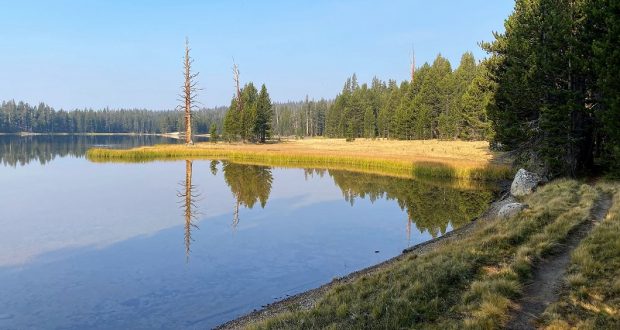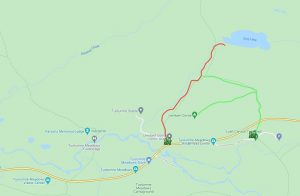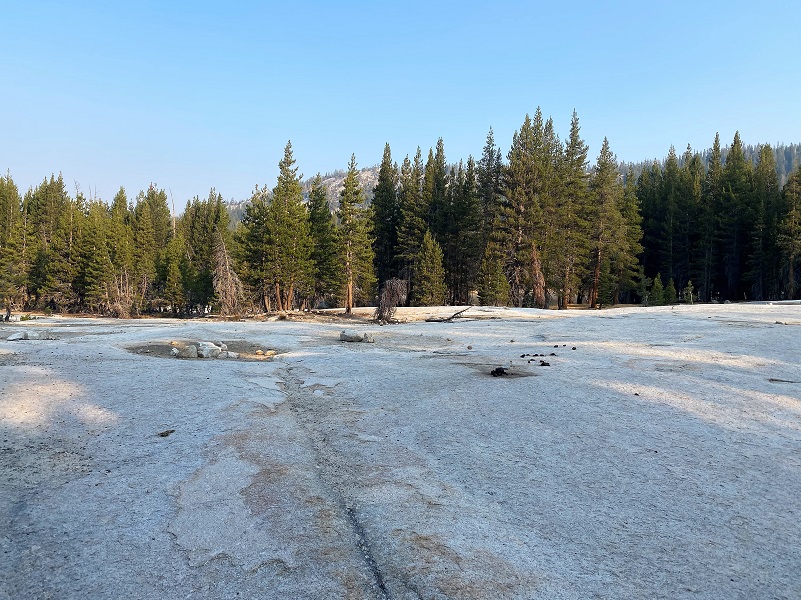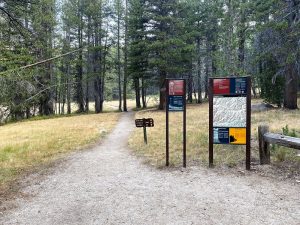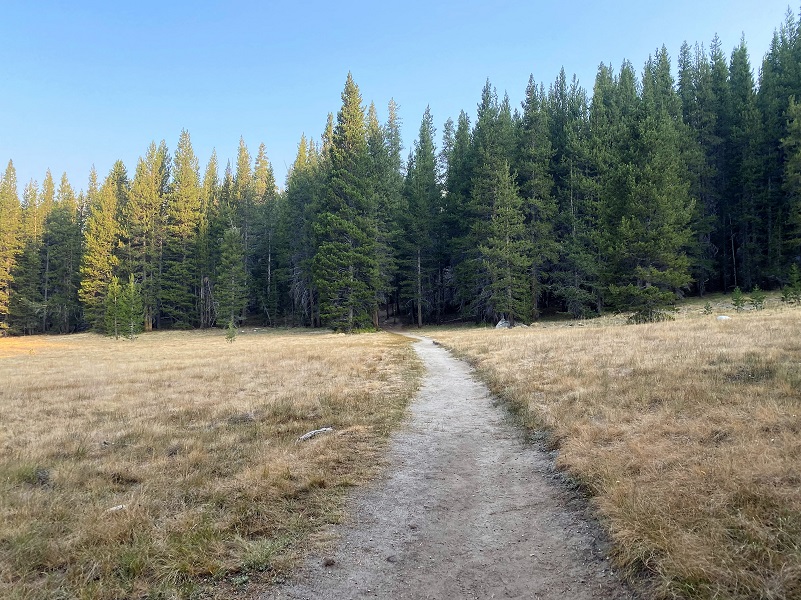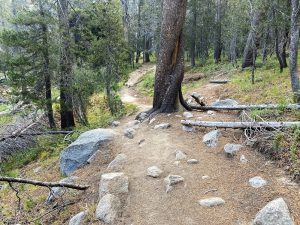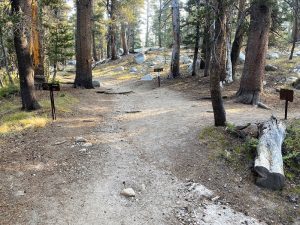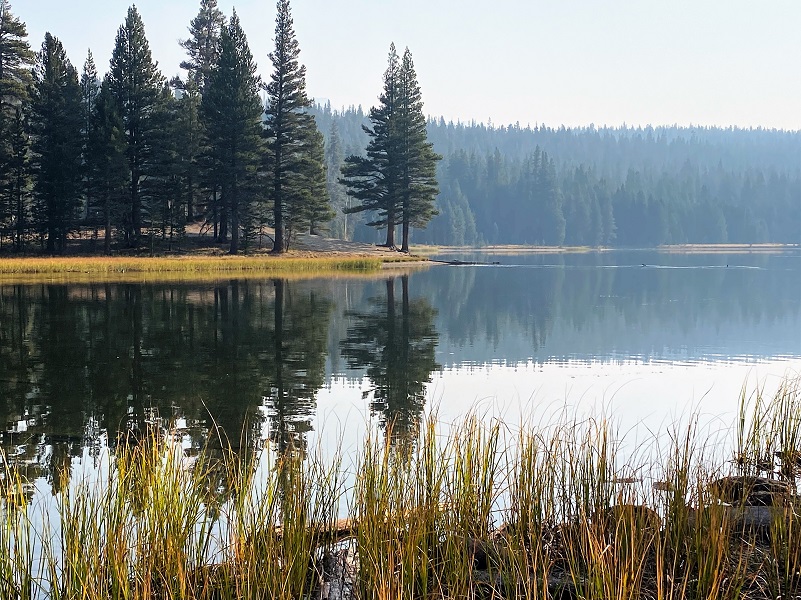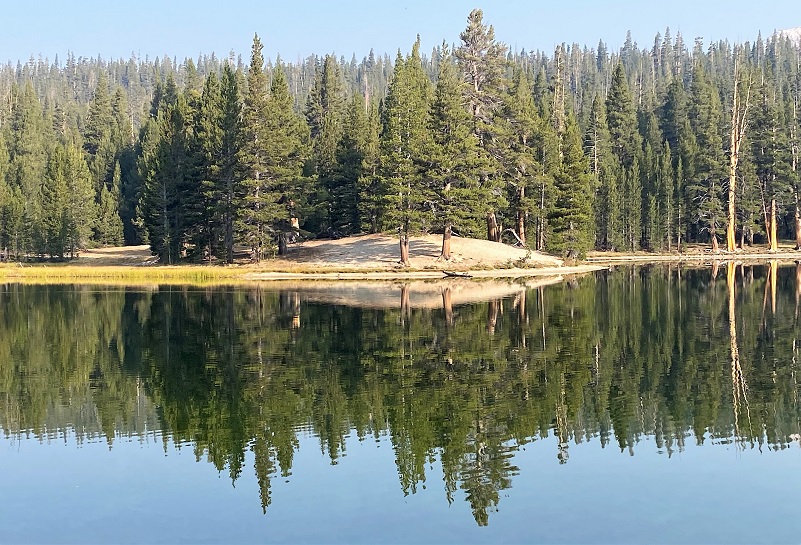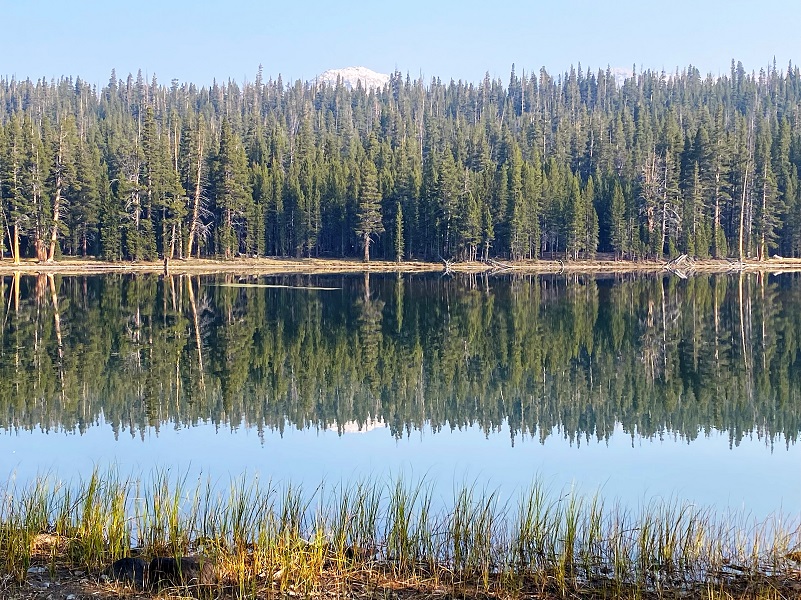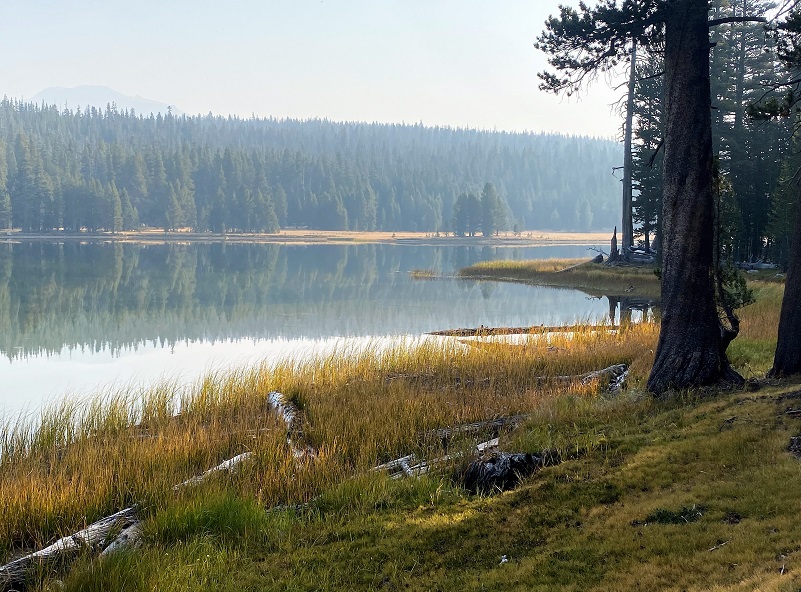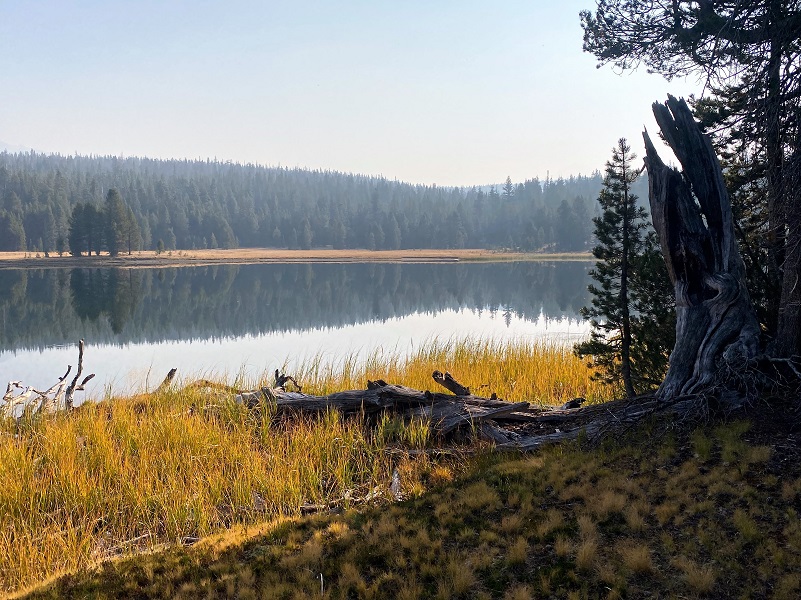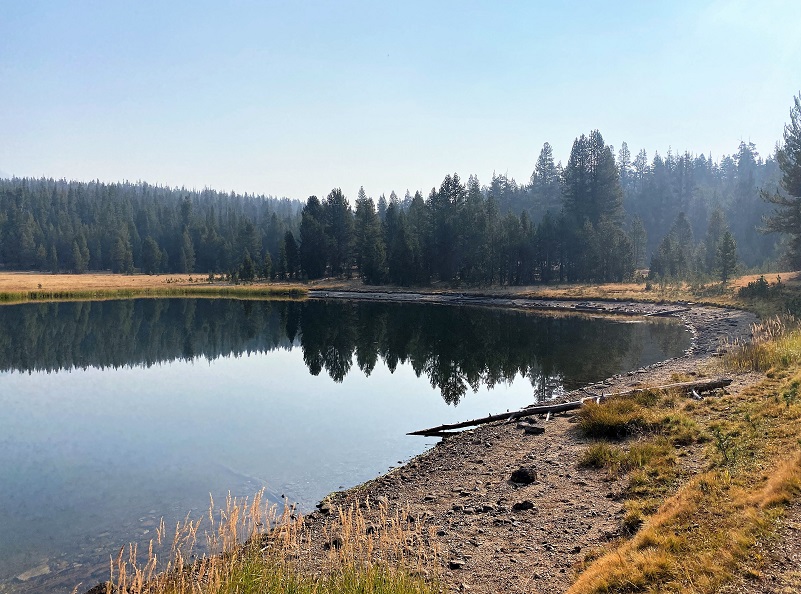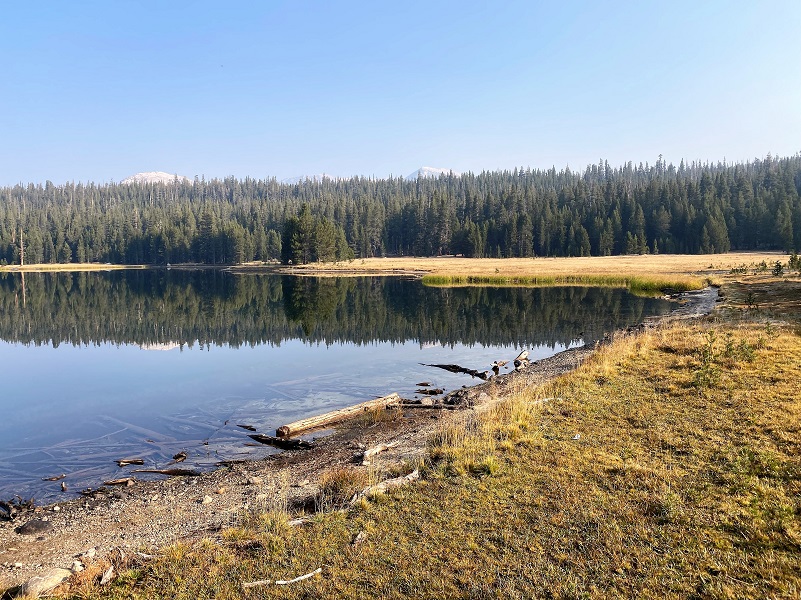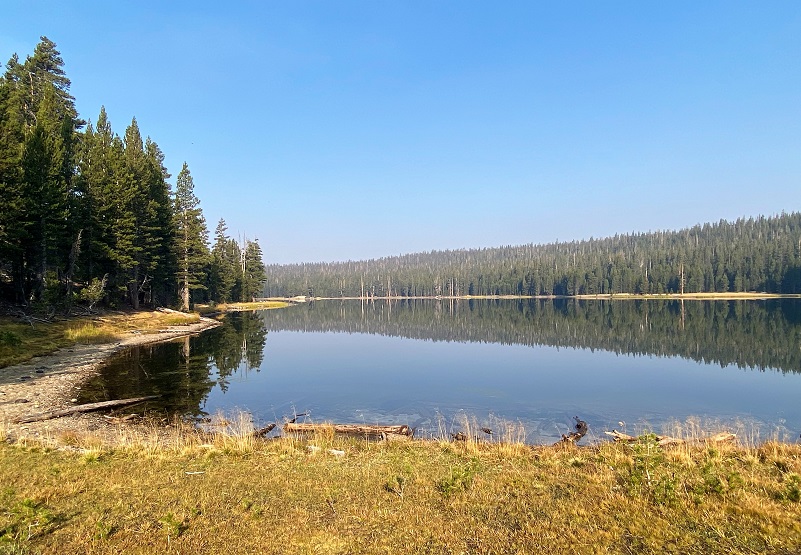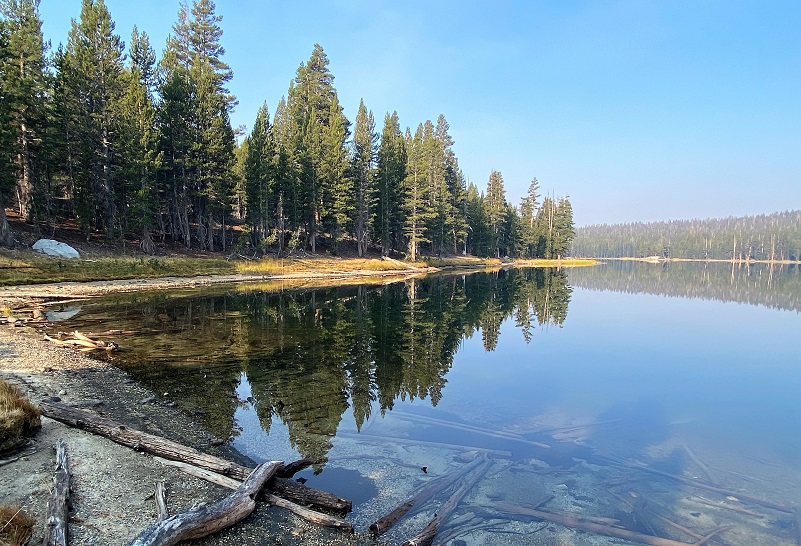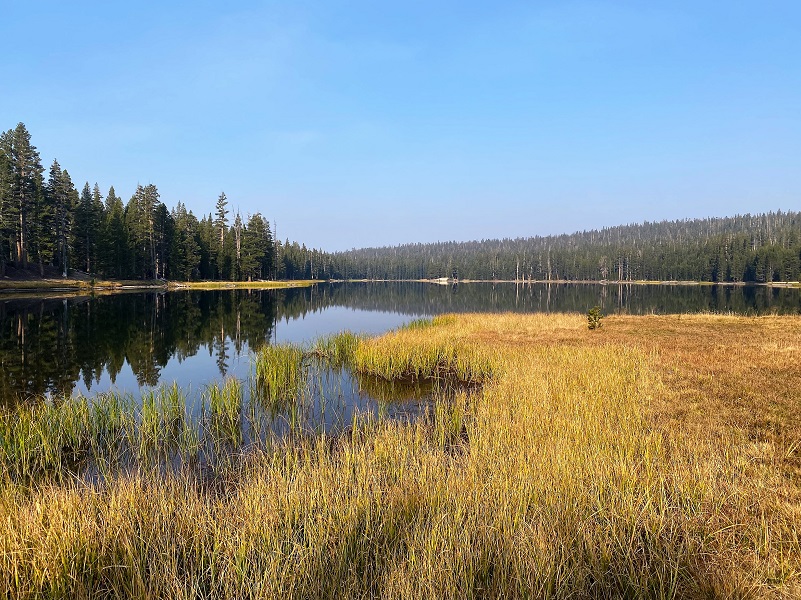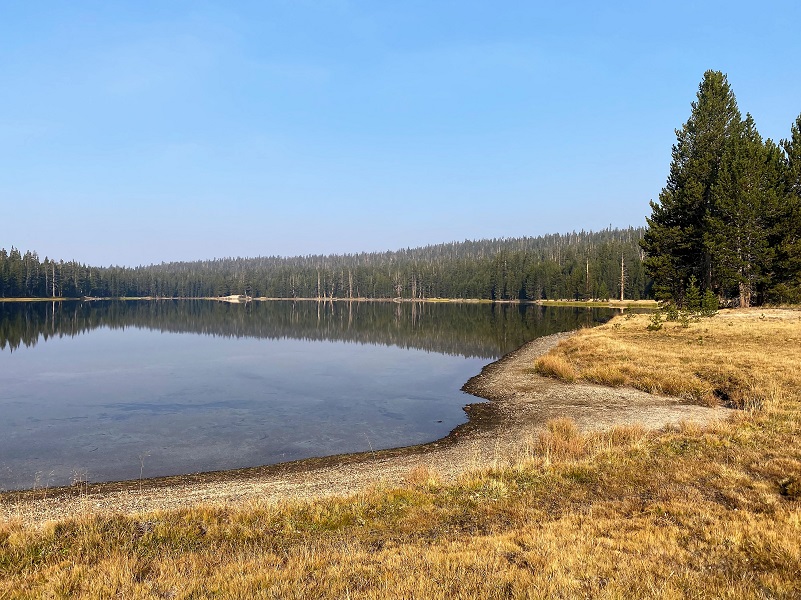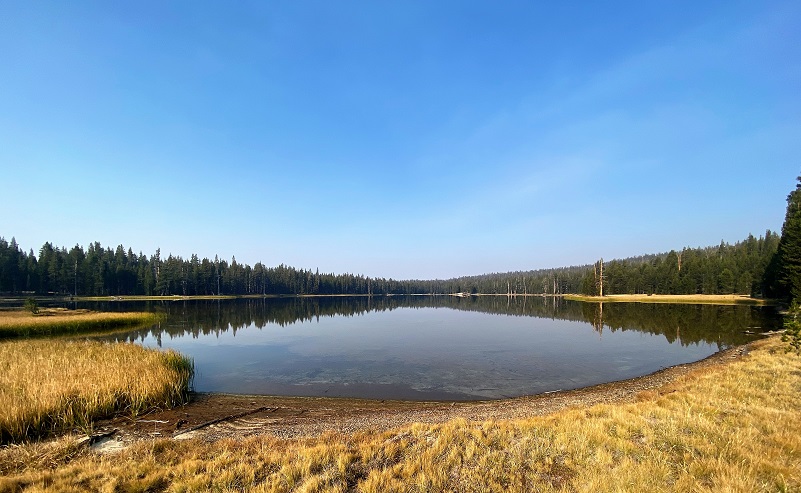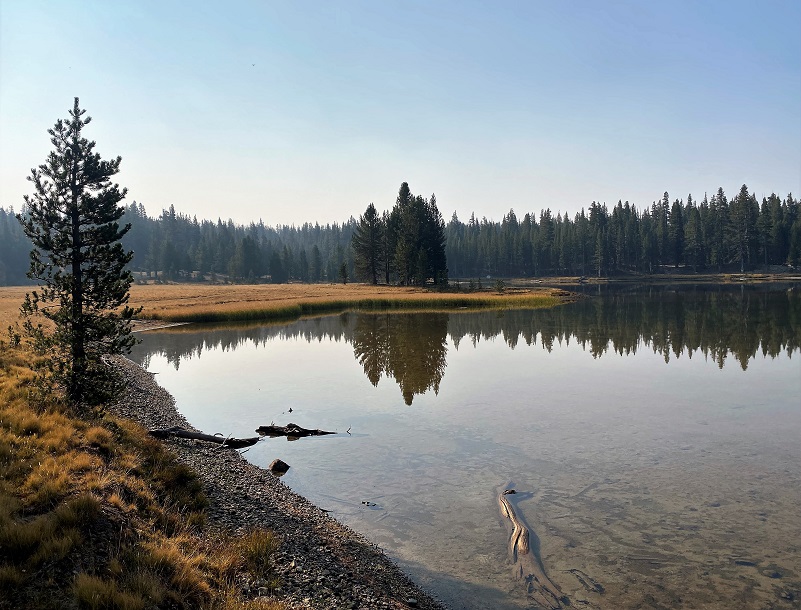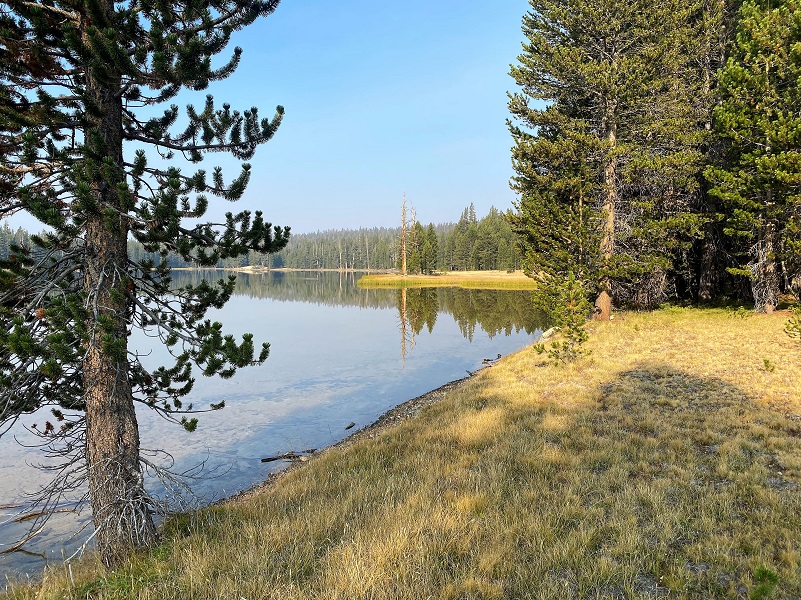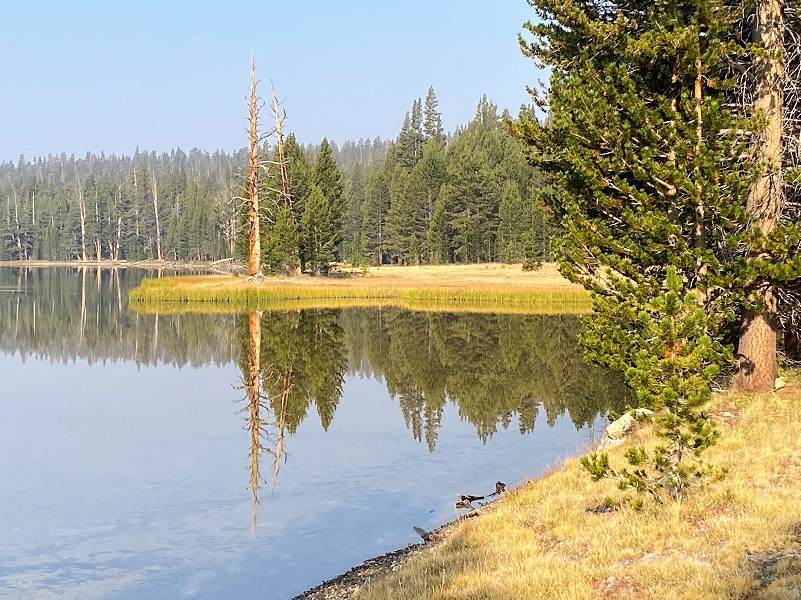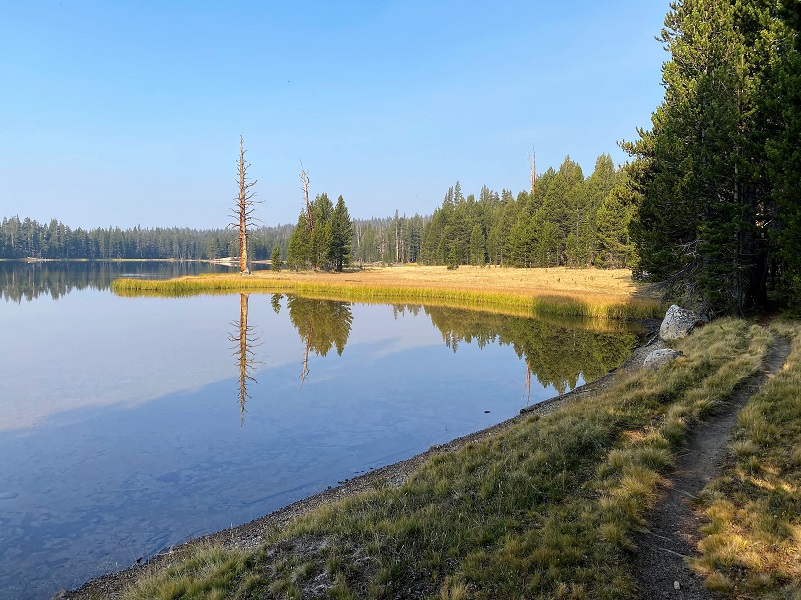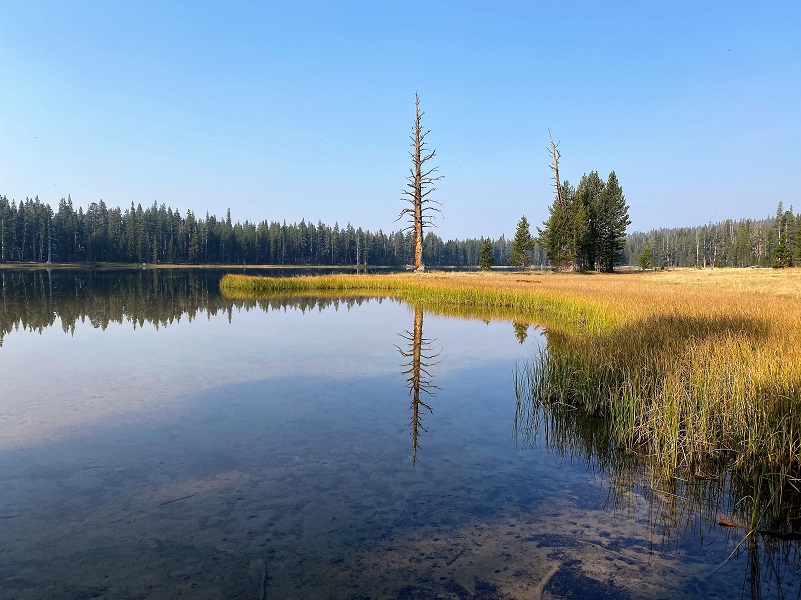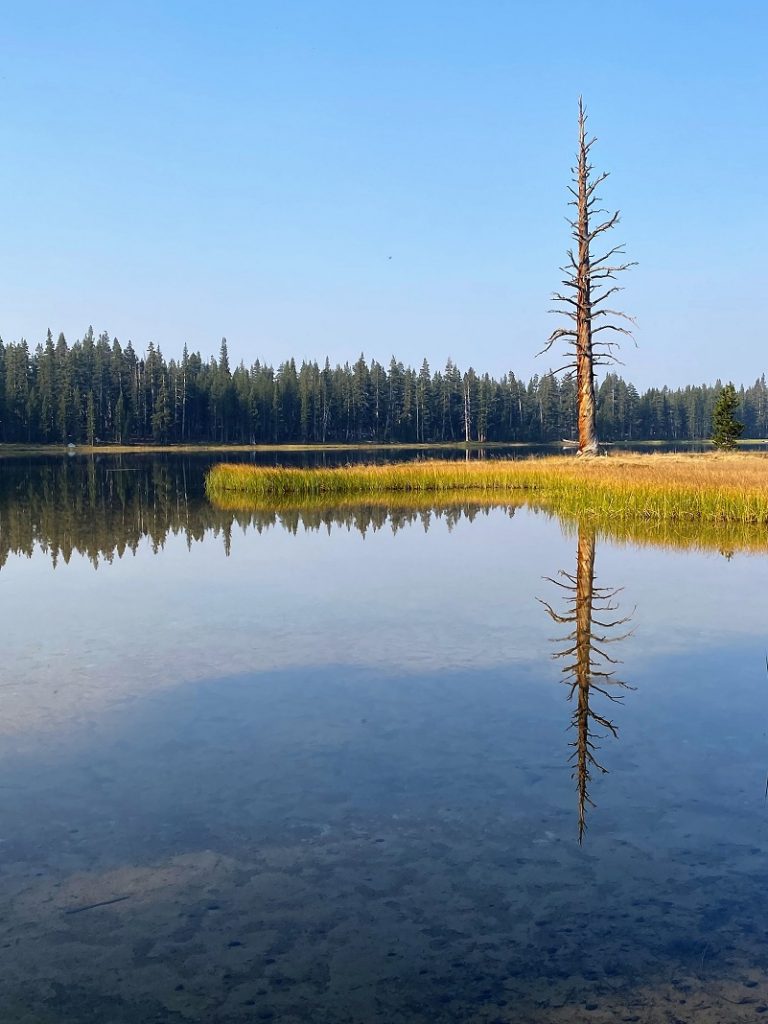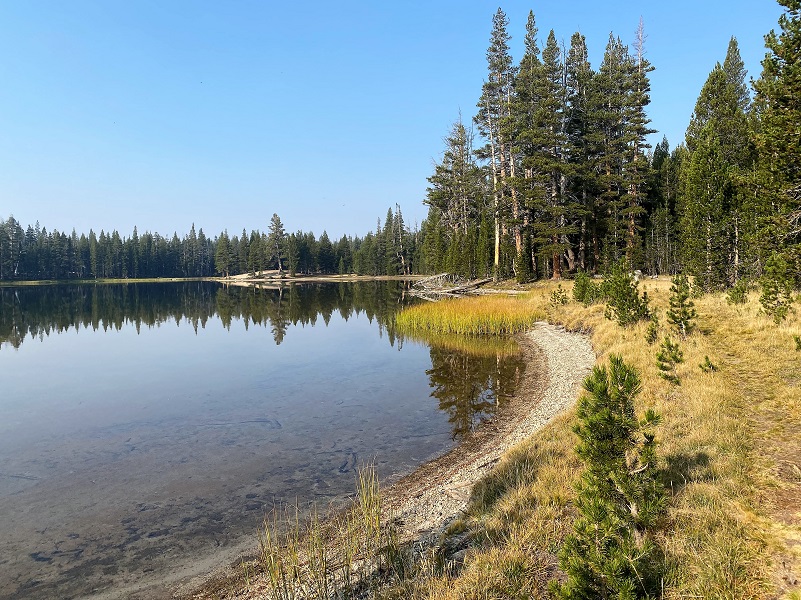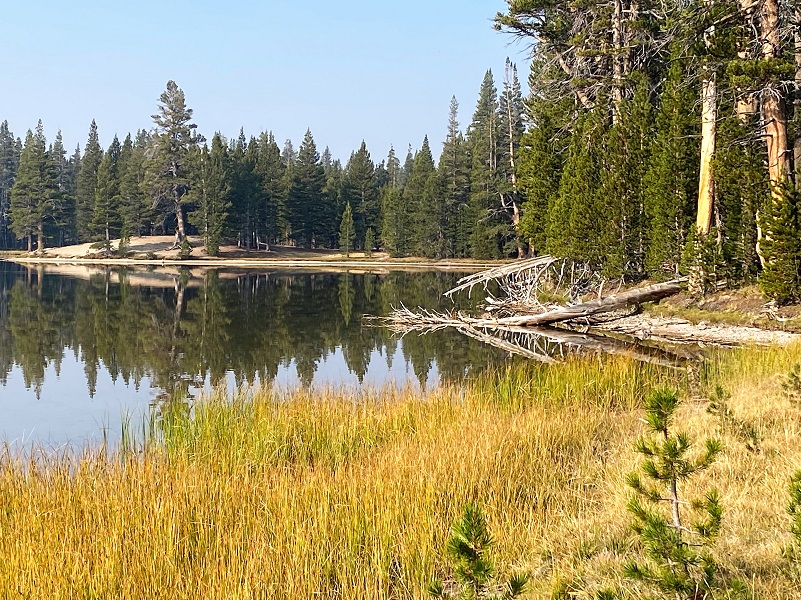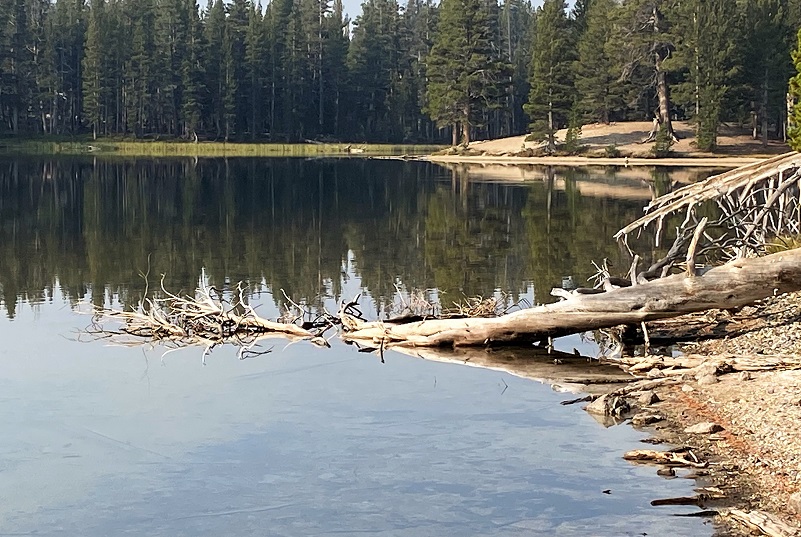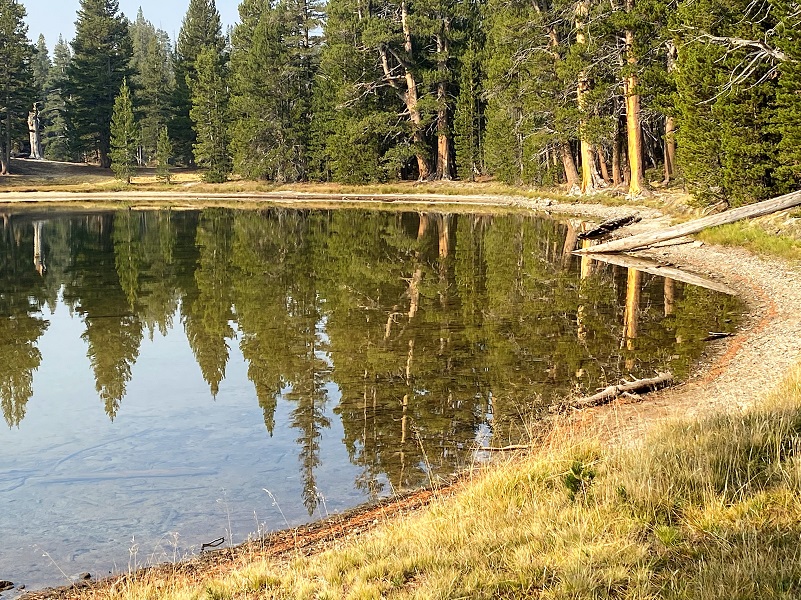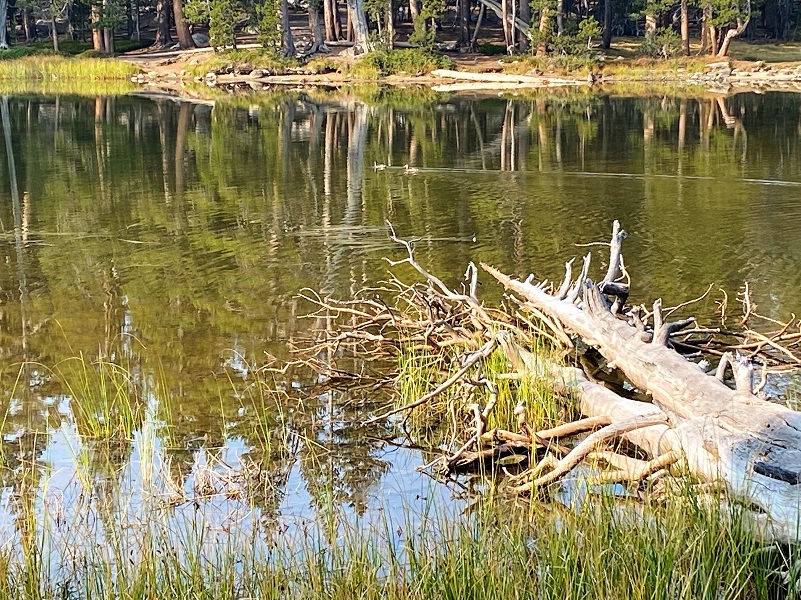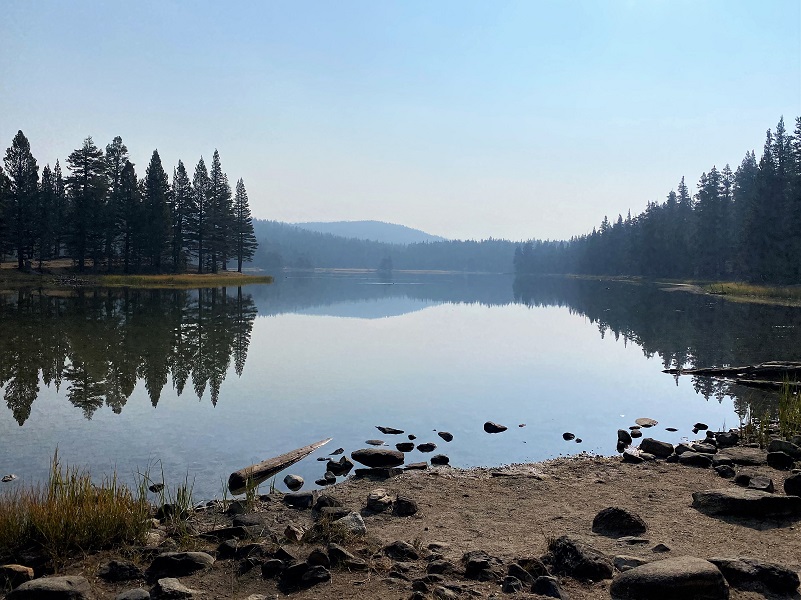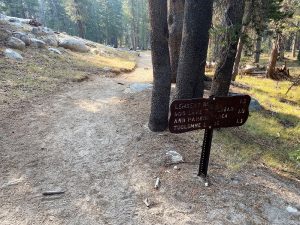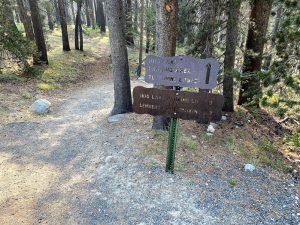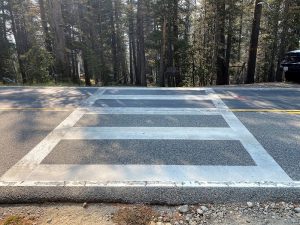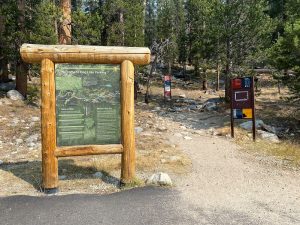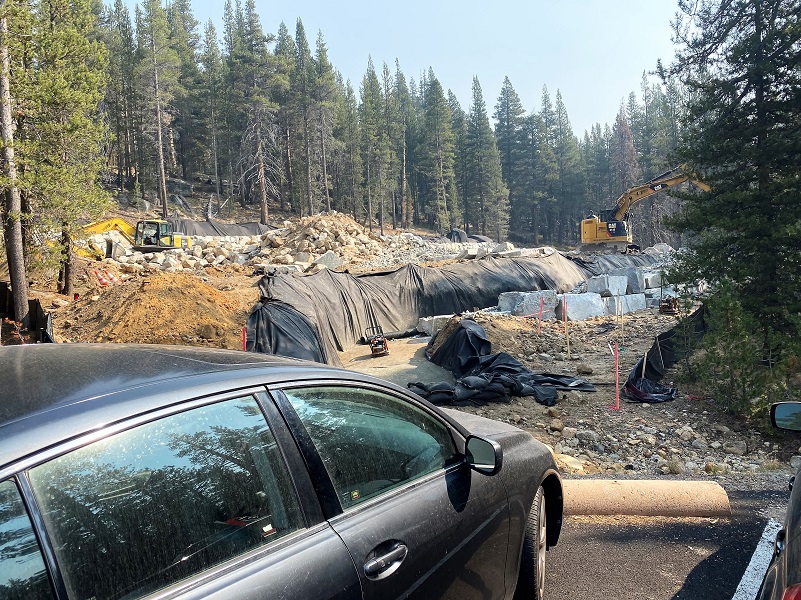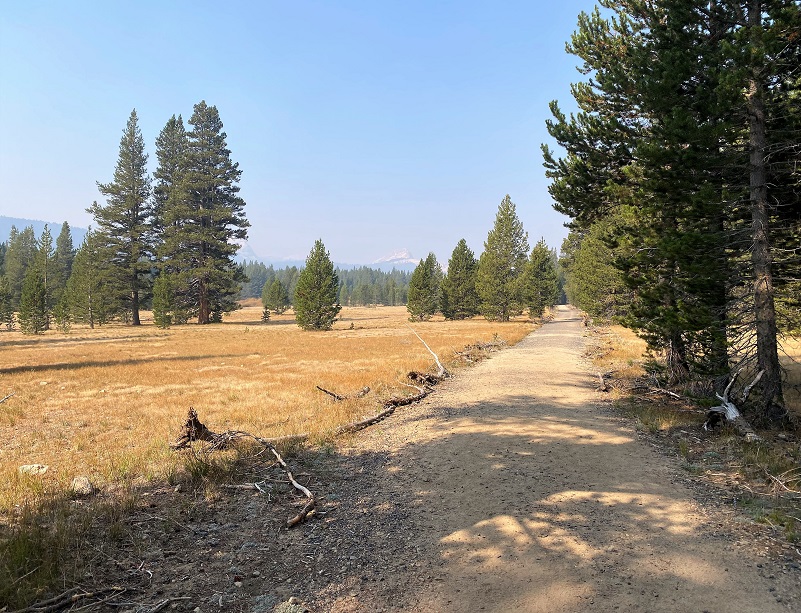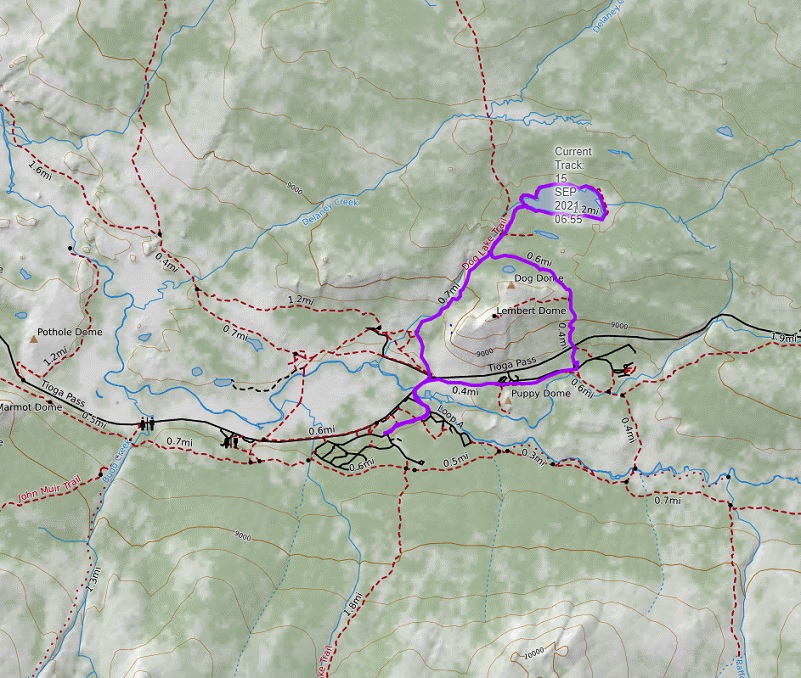Smoky reflections in a lake named for a sheepdog and her puppies, Sierra Nevada yellow-legged frogs, fishless lakes, and Tuolumne Meadows Campground’s closure played starring roles in my blog this week.
Where: Yosemite National Park
Distance: 5.76 Miles (About 5.2 Miles from the trailhead at the parking lot up to and around the lake)
Difficulty: Easy to Moderate
Elevation Range: 8,583′ – 9,189′
Elevation Gain: 676′
Date: September 17, 2021
CALTOPO: Dog Lake Hike
Dog Hike? No
I just returned from camping at Tuolumne Meadows, the final week of the season that it was open AND the last week it will be open for a few years. More about that toward the end of the blog. It was a good base camp to take a few hikes from the comfort of my campsite without driving through the many road constructions each day. Tuolumne Meadows Campground is located along Tioga Road, about 8 miles east of the Tioga Pass Entrance Station to Yosemite National Park. Campground reservations are required and whenever they reopen can be made here.
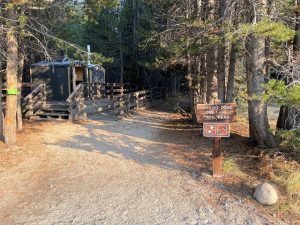 There are a couple options to start for trailheads. You can park at the Dog Lake Parking Lot off of the Tuolumne Meadows Lodge Road, east of Tuolumne Meadows, or you can start from the Trailhead from the Dog Lake/Lembert Dome Parking Lot just to the east of the bridge that crosses the Tuolumne River, which is where I started on a looped hike.
There are a couple options to start for trailheads. You can park at the Dog Lake Parking Lot off of the Tuolumne Meadows Lodge Road, east of Tuolumne Meadows, or you can start from the Trailhead from the Dog Lake/Lembert Dome Parking Lot just to the east of the bridge that crosses the Tuolumne River, which is where I started on a looped hike.
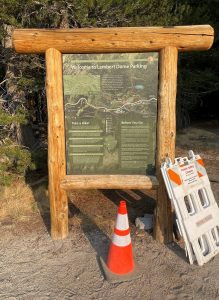 When I did this hike, they were doing a lot of construction and this parking lot was closed but people parked along the road, walking along the road to access the trailhead and restrooms. Since I was camping, I started my hike at my campsite.
When I did this hike, they were doing a lot of construction and this parking lot was closed but people parked along the road, walking along the road to access the trailhead and restrooms. Since I was camping, I started my hike at my campsite.
Following the trail located to the right of the restrooms, the trail crossed a granite slab, easy to lose the trail if you weren’t paying attention, but easy to follow the rock lined trail if you were paying attention.
The trail was well signed and I followed those signs to Dog Lake when given a choice. The trail was a beautiful one, meandering through trees and small meadows.
But pretty soon the trail started heading up for about a half mile.
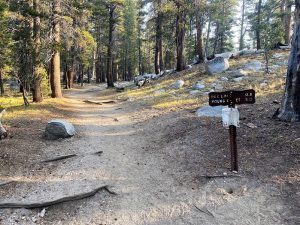 A sign was posted that Dog Lake was now a fishless Lake. When I returned home, I located more information from Yosemite National Park on why these lakes have been transitioned to fishless lakes:
A sign was posted that Dog Lake was now a fishless Lake. When I returned home, I located more information from Yosemite National Park on why these lakes have been transitioned to fishless lakes:
From 1897 to 1990 fish were stocked in lakes, ponds, streams, and rivers throughout Yosemite. In 1972, in recognition of the deleterious effects fish were having on native species, the National Park Service began phasing out its fish stocking practices. By 1975 most lakes were no longer stocked, and by 1990, Yosemite ended all fish stocking within the park. Although stocking no longer occurs, there are many self-sustaining non-native fish populations in the park. It is estimated that approximately 250 waterbodies and 800 miles of rivers and streams contain populations of nonnative fish.
I soon reached Dog Lake with smoky views to the south showing from fires in Tulare County. In 1898 Robert B. Marshall of the USGS named this lake because he found an abandoned sheepdog with a litter of puppies here, the lake first named on LeConte’s map of 1900. And I had some questions about that.
Back in the later 1800’s, sheep were grazed up in these parts during the summers but I wondered what type of dogs they could have used to help with this task. Who was the owner of this sheepdog? And, how could a sheepherder abandon one of their dogs that helped keep his flock of sheep safe? He surely must have known that she was pregnant and getting close to delivery. Those pups could grow up to be valuable sheepherders in the future. What happened to the sheepdog and her pups? Did they follow Robert B. Marshall out?
I needed to understand more about the timeline for the sheeperder so I did some digging when I returned home, locating a document titled National Park Service Cultural Landscapes Inventory 2007.
The first attempt to establish a permanent settlement in Tuolumne Meadows came around 1885, when New Yorker John Baptiste Lembert (or Lambert, as his name was frequently written) filed a homestead claim for 160 acres on the southwest quarter of Section 5, T1S, R24E. He received patent on the land in 1895. Lembert came to Yosemite at an undetermined date some years before 1885. Initially, he worked in and around Yosemite Valley, taking such jobs as winter caretaker for Snow’s Hotel at the foot of Nevada Falls. He eventually built a residence on the Merced River near Cascade Creek, where he continued to spend winters even after establishing his Tuolumne Meadows homestead. Lembert’s homestead included a corner of Soda Springs, and he constructed a wooden exclosure around the springs to protect the water from contamination by the ubiquitous herds of sheep. This exclosure resembled a small log cabin without floor or windows. It had a single door and may have originally been roofed, though it has been open to the sky during most people’s memory. The structure is the only improvement attributable to Lembert that still remains in the meadows. Not far from the springs, Lembert also built a small residential cabin at the approximate location of Parsons Lodge. It consisted of only one room with a stone foundation and fireplace and was built of round logs joined by a saddle notch and chinked with shakes. The roof was also clad with split shakes. He later built a log fence around the perimeter of his property to protect it from sheep and other livestock. For a fee, he would allow passersby to graze their livestock within this enclosure.
As already noted, one of the several business ventures which Lembert undertook was leasing his land to visitors for grazing their animals. At the time he established his homestead, there were probably more sheepherders passing through Tuolumne Meadows than tourists, but the latter were on the increase. The earliest party known to have visited Tuolumne Meadows purely for pleasure came during the summer of 1858, having hiked up Bloody Canyon from Mono Lake. The group included a woman carrying an infant.
John Lembert was found murdered in his lower Merced River cabin during the winter of 1896, presumably for his money but his murderer was never found. After Lembert was murdered, his brother Jacob sold the property in 1898 to James McCauley’s two sons, John and Fred. James McCauley’s sons continued the tradition of ranching which their father had begun at Big Meadow. The Tuolumne addition to their now-extensive holdings was obviously acquired to provide additional pasturage for their livestock. This would become a point of contention between the McCauley brothers and the Army administration who took responsibility for the management of Tuolumne Meadows after 1890, since the McCauleys had to drive their stock across federal land in order to reach their quarter section inholding at Soda Springs. In 1902, the McCauleys built a one-story cabin, which they used as a seasonal bunkhouse. They also replaced Lembert’s original boundary fence, which had collapsed by this date. The McCauley cabin still stands and is maintained by the National Park Service, but Lembert’s improvements have long since dissolved into the soil, with the sole exception of the exclosure around the soda springs at the southeast corner of his property. The structure is no longer needed to keep out thirsty livestock but is preserved nonetheless and helps mark the location of this natural water feature.
As far as I have heard the McCauleys raised cattle and horses, not sheep. So, based on the timeframe and location, it appears that the sheepherder who lost his dog could have been a grazing lease from Lembert circa 1896 or perhaps shortly after John and Fred McCauley purchased the property in 1898. Perhaps before the McCauley’s got their summer cattle grazing operation settled in Tuolumne Meadows, they leased grazing rights but I would place bets on a holdover sheepherder from the Lembert grazing leases.
And what about that sheepherder? I tried to locate old pictures of sheep herds and herders from that timeframe and area, locating the below undated one taken in Tuolumne Meadows from Yosemite National Park.
I searched the 1880 California census for people who listed their occupation as sheepherders, finding quite the diversity from various states in the United States, Ireland, France, Sweden, Mexico, Azores, Basque, Japan, China and Germany. Did you know that John Muir worked as a sheepherder for a short while?
I wondered where Robert B. Marshall’s survey party might have come from before they reached Dog Lake and where they headed from there. Maybe that might give me a clue related to where they found the dog and if they brought it out with them. I wondered if Robert B. Marshall’s survey journal might be available online and I searched when I got home with no success. I didn’t get all of my questions answered so am still pondering some of them.
I took a walk around the lake, the smoke coming and going throughout my walk. There are a couple of ways to view the pictures. You can just scroll down the page, clicking on one that you wish to view larger. Or you can click on the first picture and as in a slideshow, click on the right hand arrow to take you to the next pictures.
When I completed my walk around Dog Lake, I headed back on the same trail I had come up except once I reached the junction to Lembert Dome, I followed that trail. My Plan A was to walk up to the top of Lembert Dome to check out the view of Tuolumne Meadows but the smoke had really began to roll in. I knew it wouldn’t be much of a view and decided it wasn’t worth the effort. So I went to Plan B, heading down to the Dog Lake Parking Area to make a looped hike.
A whole lot of construction has been taking place in Tuolumne Meadows this summer but I hadn’t been down to the area of Tuolumne Lodge to see what was going on there. When they are finished, this parking area is going to be much larger.
The air was definitely smokier as I headed back toward the Tuolumne Meadows Campground.
Tuolumne Meadows Campground is now closed for the season but Yosemite National Park recently announced that the Tuolumne Meadows Campground Closed Until 2024 or 2025 for construction. Here is what they recently shared:
Tuolumne Meadows Campground Closed Until 2024 or 2025
A major project to rehabilitate the Tuolumne Meadows Campground is underway. As a result, the campground will be closed until 2024 or 2025 (depending on length of construction season, weather delays, etc.). No camping of any kind will be available at Tuolumne Meadows during this time. The backpackers campground will also be closed (link for more info for backpackers).
What will be different when the campground reopens?
- Improved and simplified road system
- Rehabilitated restrooms, with two new restrooms added
- Redesigned campsites with hardened parking pads
- Seventeen campsites relocated from along the river in A loop to an area away from the river (no change in the total number of campsites in the campground)
- Backpackers campground relocated within the campground to the John Muir Trail trailhead
- Twelve walk-to campsites (with nearby parking)
- New picnic tables, food lockers, fire rings in each campsite
- Improved accessibility for people with disabilities, including at the Dana Campfire Circle
- Updated water and sewer system
Campground Facts
- Built in 1931–1934 by the Civilian Conservation Corps and expanded in the 1960s (currently 140 acres)
- It has 304 drive-in campsites, seven group sites, four horse sites, and 21 backpacker sites and servers about 141,000 visitors per year
- This project implements a portion of the 2014 Tuolumne River Plan (link)
Dog Hike?
No, dogs not allowed in Yosemite National Park Wilderness.
Doarama:
What is a Doarama? It is a video playback of the GPS track overlaid on a 3 dimensional interactive map. If you “grab” the map, you can tilt it or spin it and look at it from different viewing angles. With the rabbit and turtle buttons, you can also speed it up, slow it down or pause it.
Dog Lake Doarama
Map and Profile:
CALTOPO has some free options for mapping and here is a link to my hike this week, which you can view or download: CALTOPO: Dog Lake Hike
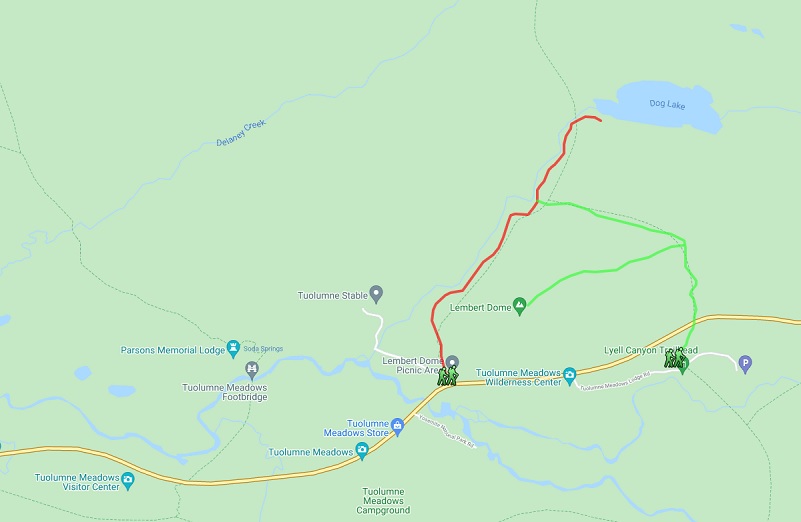
Dog Lake Trailhead Map (Yosemite National Park) https://www.yosemitehikes.com/tioga-road/dog-lake/trail-map.htm
Sources:
Browning, Peter, Yosemite Place Names, Great West Books, Lafayette California, 1988
National Park Service Cultural Landscapes Inventory 2007
Sierra Nevada Yellow-Legged Frog Yosemite National Park
Aquatic Restoration Yosemite National Park
Sierra Nevada Bighorn Sheep – Disease Yosemite National Park
Prior Blogs in This Area:
Hiking From Tuolumne Meadows To Elizabeth Lake September 16, 2021
Tuolumne Meadows to Elizabeth and Nelson Lakes Hike July 26, 2013

